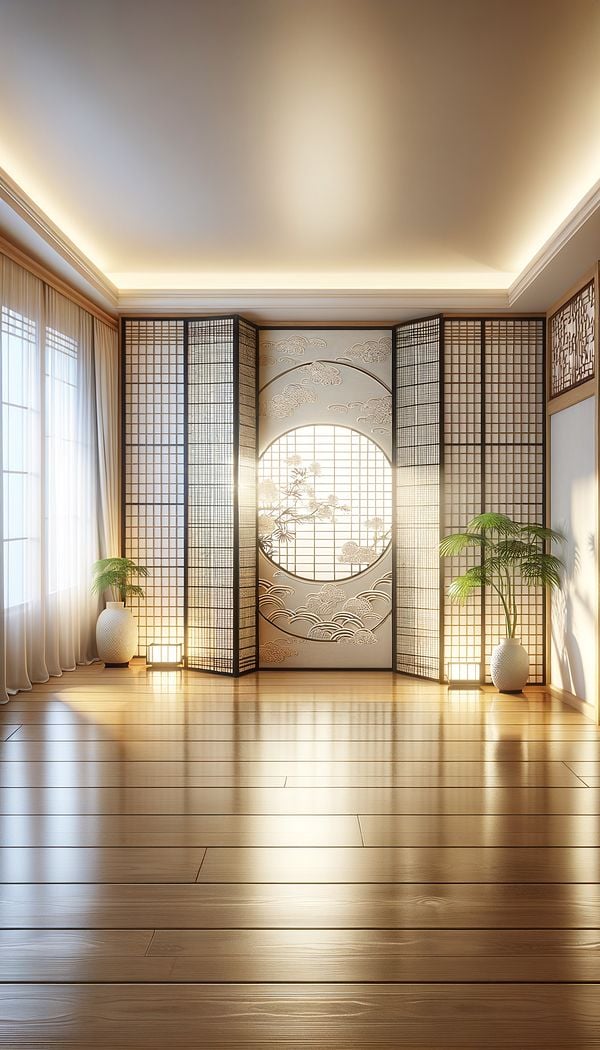What is a Shoji Screen?
A shoji screen is a traditional Japanese room divider made of translucent paper and a wooden frame.
Description
A shoji screen reflects a hallmark of traditional Japanese architecture and design, embodying both functionality and aesthetic beauty. It comprises a wooden frame fitted with translucent paper, often rice paper, that allows light to pass through while providing privacy. The construction of a shoji screen is both simple and intricate, with fine wooden lattice work (kumiko) that may feature various geometric patterns or designs. These screens have been a fundamental element in Japanese homes for centuries, serving as room dividers, window coverings, or simply as decorative pieces.
The use of shoji screens has spread beyond Japan, finding a place in modern interior designs around the world. Their ability to softly diffuse light and create subtle spatial separations makes them a popular choice for adding a touch of Japanese aesthetics to a variety of spaces. In contemporary settings, shoji screens can be found in both their traditional form and in modern adaptations, incorporating materials like glass or acrylic in place of the classic paper.
The appeal of shoji screens lies in their versatility, lightweight nature, and the serene ambiance they introduce. By blending the practicalities of space division with the philosophic principles of Japanese design, such as minimalism and the harmonious balance between space and form, shoji screens enrich living spaces with a sense of calm and elegance.
Usage
Shoji screens are often used in living rooms, bedrooms, and spaces that require subtle division without the need for solid barriers. In contemporary interior design, they may be employed as movable partitions, closet doors, or even as a backdrop for a home office setup. In addition to their functional uses, shoji screens serve as a key element in Japanese inspired design styles, bringing a distinctive element of tranquility and simplicity.
FAQs
-
Are all shoji screens made with paper?
Traditionally, shoji screens are made with translucent paper, typically rice paper. However, modern adaptations may use materials like glass or acrylic for durability and different aesthetic effects.
-
Can shoji screens be used outdoors?
While traditionally used indoors, modern versions of shoji screens designed for outdoor use incorporate weather-resistant materials. It's essential to choose screens specifically made for outdoor conditions.
-
How do shoji screens affect the lighting in a room?
Shoji screens softly diffuse light, creating a warm and inviting ambiance. They allow natural light to penetrate the space while providing privacy, making them ideal for areas that benefit from soft, filtered light.
Practical Application
When incorporating shoji screens into your interior design, consider their light-diffusing qualities to enhance the ambiance of a space. Use them to create distinctive areas within a room without resorting to permanent partitions. For a modern twist, explore variations that incorporate non-traditional materials or designs. Regular maintenance, such as dusting and careful handling, is crucial, especially for screens made with traditional paper, to preserve their beauty and functionality.
-
Architectural Elements199 articles
-
Design Styles478 articles
-
Decorative Techniques322 articles
-
Window Treatments65 articles
-
Materials & Textiles360 articles
-
RusticRustic refers to a design style that embraces natural, rugged, and aged elements to create an authentic and earthy feel.
-
NRC - Noise Reduction CoefficientNRC is a standard measure to indicate how much sound an acoustic material can absorb.
-
ChinoiserieChinoiserie is a style inspired by Chinese artistic influences.
-
American OrientalAmerican Oriental is a design style that merges traditional American design elements with Oriental influences.
-
Venetian BlindA Venetian blind is a type of window covering made of horizontal slats that can be adjusted to control light and visibility.
